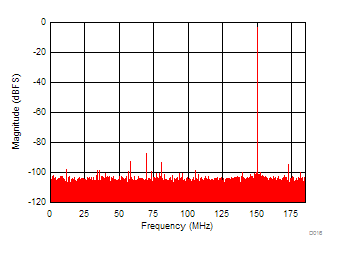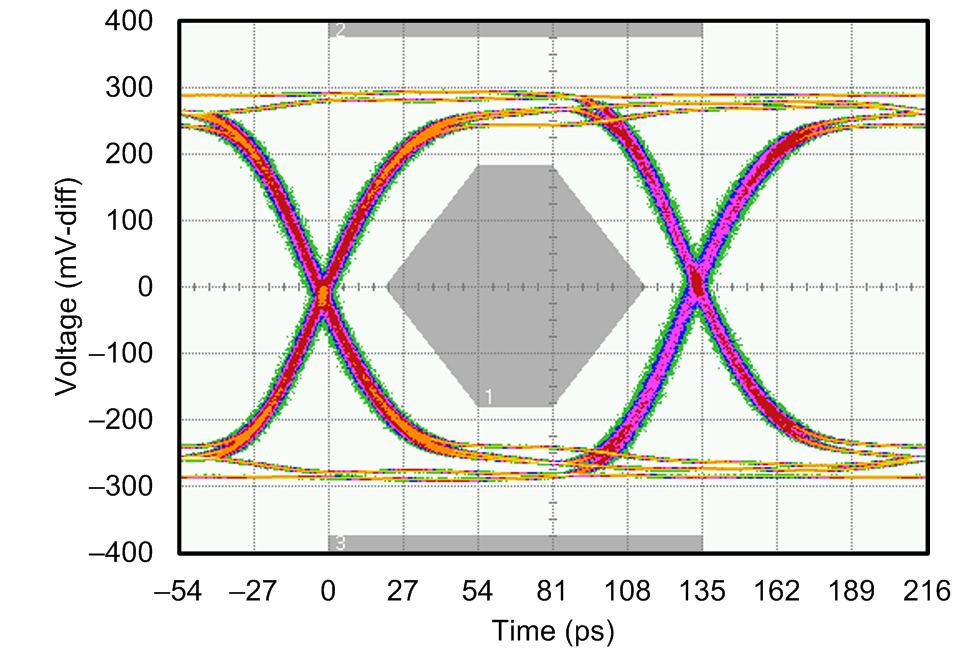SNVSA18C April 2014 – August 2014 ADC16DX370
PRODUCTION DATA.
- 1 Features
- 2 Applications
- 3 Description
- 4 Revision History
- 5 Pin Configuration and Functions
-
6 Specifications
- 6.1 Absolute Maximum Ratings
- 6.2 Handling Ratings
- 6.3 Recommended Operating Conditions
- 6.4 Thermal Information
- 6.5 Converter Performance Characteristics
- 6.6 Power Supply Electrical Characteristics
- 6.7 Analog Interface Electrical Characteristics
- 6.8 CLKIN, SYSREF, SYNCb Interface Electrical Characteristics
- 6.9 Serial Data Output Interface Electrical Characteristics
- 6.10 Digital Input Electrical Interface Characteristics
- 6.11 Timing Requirements
- 6.12 Typical Characteristics
- 7 Parameter Measurement Information
-
8 Detailed Description
- 8.1 Overview
- 8.2 Functional Block Diagram
- 8.3
Feature Description
- 8.3.1 Amplitude and Phase Imbalance Correction of Differential Analog Input
- 8.3.2 DC Offset Correction
- 8.3.3 Over-Range Detection
- 8.3.4 Input Clock Divider
- 8.3.5 SYSREF Offset Feature and Detection Gate
- 8.3.6 Sampling Instant Phase Adjustment
- 8.3.7 Serial Differential Output Drivers
- 8.3.8 ADC Core Calibration
- 8.3.9 Data Format
- 8.3.10 JESD204B Supported Features
- 8.3.11 Transport Layer Configuration
- 8.3.12 Test Pattern Sequences
- 8.3.13 JESD204B Link Initialization
- 8.3.14 SPI
- 8.4 Device Functional Modes
- 8.5 Register Map
- 9 Application and Implementation
- 10Power Supply Recommendations
- 11Layout
- 12Device and Documentation Support
- 13Mechanical, Packaging, and Orderable Information
1 Features
- Resolution: 16-Bit
- Conversion Rate: 370 MSPS
- 1.7 VP-P Input Full Scale Range
- Performance:
- Input: 150 MHz, –3 dBFS
- SNR: 69.6 dBFS
- Noise Spectral Density: –152.3 dBFS/Hz
- SFDR: 88 dBFS
- Non-HD2 and Non-HD3 SPUR: –90 dBFS
- Input: 150 MHz, –3 dBFS
- Power Dissipation: 800 mW/channel
- Buffered Analog Inputs
- On-Chip Precision Reference Without External Bypassing
- Input Sampling Clock Divider With Phase Synchronization (Divide-by- 1, 2, 4, or 8)
- JESD204B Subclass 1 Serial Data Interface
- Lane Rates up to 7.4 Gb/s
- Configurable as 1- or 2-Lanes/Channel
- Fast Over-Range Signals
- 4-Wire, 1.2-V, 1.8-V, 2.5-V, or 3-V Compatible Serial Peripheral Interface (SPI)
- 56-Pin WQFN Package, (8 × 8 mm, 0.5-mm Pin-Pitch)
2 Applications
- High IF Sampling Receivers
- Multi-Carrier Base Station Receivers
- GSM/EDGE, CDMA2000, UMTS, LTE, WiMax
- Diversity, Multi-Mode, and Multiband Receivers
- Digital Pre-Distortion
- Test and Measurement Equipment
- Communications Instrumentation
- Portable Instrumentation
3 Description
The ADC16DX370 device is a monolithic dual-channel high performance analog-to-digital converter capable of converting analog input signals into 16-bit digital words with a sampling rate of 370 MSPS. This converter uses a differential pipelined architecture with integrated input buffer to provide excellent dynamic performance while maintaining low power consumption.
The integrated input buffer eliminates charge kickback noise coming from the internal switched capacitor sampling circuits and eases the system-level design of the driving amplifier, anti-aliasing filter, and impedance matching. An input sampling clock divider provides integer divide ratios with configurable phase selection to simplify system clocking. An integrated low-noise voltage reference eases board level design without requiring external decoupling capacitors. The output digital data is provided through a JESD204B subclass 1 interface from a 56-pin, 8-mm × 8-mm WQFN package. A SPI is available to configure the device that is compatible with 1.2-V to 3-V logic.
Device Information(1)
| PART NUMBER | PACKAGE | BODY SIZE (NOM) |
|---|---|---|
| ADC16DX370 | WQFN (56) | 8.00 × 8.00 mm |
- For all available packages, see the orderable addendum at the end of the data sheet.
SPACE
1-Tone Spectrum, 150 MHz

Output Serial Lane Eye Diagram at 7.4 Gb/s
